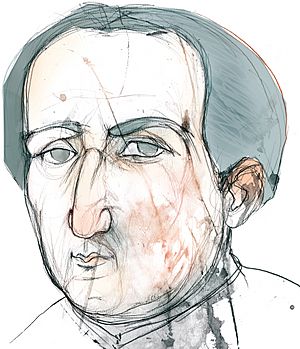Abraham Zacuto facts for kids
Quick facts for kids
Abraham Zacuto
|
|
|---|---|
 |
|
| Born | August 12, 1452 |
| Died | 1515 (aged 62–63) |
Abraham Zacuto (Hebrew: אַבְרָהָם בֵּן שְׁמוּאֵל זַכּוּת, romanized: Avraham ben Shmuel Zacut, Portuguese: Abraão ben Samuel Zacuto; 12 August 1452 – c. 1515) was a brilliant person from Castile (part of modern-day Spain). He was an astronomer, a mathematician, a rabbi, and a historian. He even worked as the Royal Astronomer for King John II of Portugal.
Zacuto created special tools and charts that were very important for sailors. His astrolabe (a tool to measure star positions), his astronomy tables, and his sea maps helped explorers like Vasco Da Gama and Christopher Columbus find their way across the oceans.
Contents
Life Story
Abraham Zacuto was born in Salamanca, Castile (which is now in Spain), in 1452. He likely studied and taught astronomy at the University of Salamanca. Later, he taught at other universities in Zaragoza and Carthage. He was also a respected rabbi in his community, meaning he was an expert in Jewish Law.
In 1492, the rulers of Spain, known as the Catholic Monarchs of Spain, ordered all Jewish people to leave the country. This was called the Alhambra Decree. Zacuto had to leave Spain and found safety in Lisbon, Portugal. Because he was already famous for his knowledge, King John II of Portugal invited him to his royal court. The king made him his Royal Astronomer and Historian.
Zacuto held this important job until the start of King Manuel I's rule. King John II often asked Zacuto for advice about finding a sea route to India. Zacuto strongly supported this idea and encouraged the king to pursue it.
Later, King Manuel I made it very difficult for Jewish people to leave Portugal. He wanted them to stay and become Christians, at least in name. Zacuto was one of the few who managed to escape Portugal during this time. He first went to Tunis (in North Africa) and later moved to Jerusalem. He probably passed away in Jerusalem around 1515. Some reports say he died in Damascus in 1520. Like other important Jewish scholars, he wanted to be buried near Jerusalem.
His Important Work
Abraham Zacuto invented a new kind of astrolabe. This special astrolabe was designed to help sailors figure out their exact position (latitude) while they were at sea. Before this, astrolabes were mostly used on land.
The Great Book
Zacuto's most famous work is a large book about astronomy. He wrote it in Hebrew while he was in Salamanca. The book is called Ha-ḥibbur ha-gadol, which means "The Great Book." He started writing it around 1470 and finished in 1478.
This book contained 65 detailed tables of astronomical information. These tables showed the positions of the Sun, Moon, and five planets for many years, starting from 1473. The calculations were based on older astronomy works. Zacuto made the data easy to use, like an "almanac," so sailors could quickly find the information they needed.
The book was first translated into Castilian in 1481. Later, Zacuto's student, Joseph Vizinus, translated it into Latin. This Latin version was called Tabulae tabularum Celestium motuum sive Almanach perpetuum, or "Perpetual Almanac." It was printed in 1496 in Portugal, making it one of the first books printed there using a movable type printing press.
Zacuto's Almanach perpetuum (also known as Biur luḥot) changed how people navigated on the ocean. Before this book, sailors used a tool called a quadrant and the Pole Star to find their way. But this method didn't work well near the equator, where the Pole Star disappears from view.
Zacuto's Almanac provided the first accurate tables that showed the Sun's declination (its position in the sky). This meant sailors could use the Sun instead of the Pole Star. Since you can't look directly at the Sun with a quadrant, Portuguese sailors started using the astrolabe on their ships. Zacuto's tables, combined with the new metal astrolabe, allowed sailors to get accurate readings anywhere in the world.
In 1497, Vasco da Gama took Zacuto's tables and the astrolabe with him on his first trip to India. These tools continued to be used by Portuguese ships for long journeys to places like Brazil and India.
Zacuto also helped train Vasco da Gama and his crew. He taught them how to use the new instruments before they sailed to India in 1496. Even before that, Christopher Columbus had used Zacuto's tables. There's a famous story that on one of his voyages, when facing angry natives, Columbus knew from Zacuto's tables that an eclipse was coming. He used this knowledge to scare the natives, making them believe he could make the Sun and Moon disappear. This story suggests Zacuto's work saved Columbus and his crew.
Other Books
In 1504, while in Tunisia, Abraham Zacuto wrote a history book about the Jewish people. It was called Sefer yuḥasin. This book covered history from the Creation of the World up to the year 1500. He also wrote other books about astronomy and astrology. His history book was very popular and was reprinted many times over the centuries.
His Lasting Impact
Abraham Zacuto might have inspired a character in a famous Portuguese poem called Os Lusíadas, written by Luís de Camões in 1572. This character, "the Old Man of Restelo," warns Vasco da Gama about the dangers of his journey just before he leaves. This might be based on a real meeting where Zacuto gave Gama some final navigation tips and warnings.
There is a small museum named after him in Portugal, called the Abraham Zacuto Portuguese Jewish Museum (Portuguese: Museu Luso-Hebraico Abraão Zacuto). It was founded in 1939 and is located in a former Synagogue of Tomar.
Also, a crater on the Moon is named after him. It's called Zagut.
See also
 In Spanish: Abraham Zacuto para niños
In Spanish: Abraham Zacuto para niños


